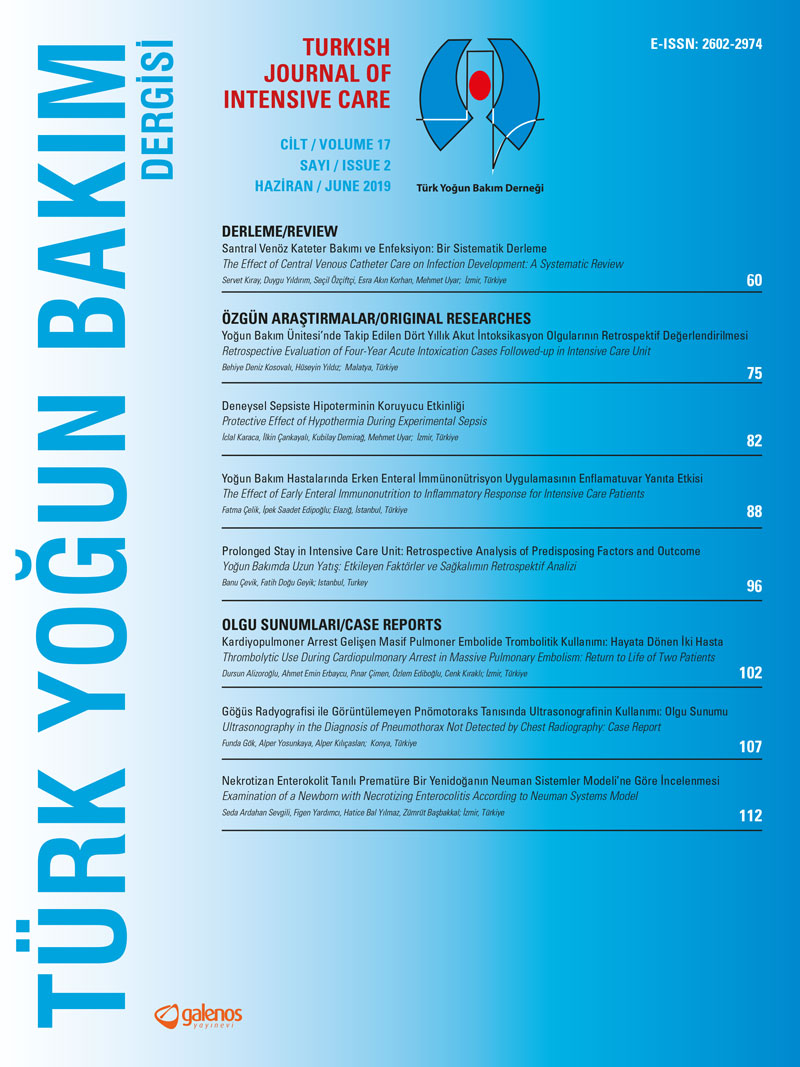Öz
Amaç:
Çalışmamızda çekal ligasyon-perforasyon işlemi ile sepsis oluşturduğumuz rat modellerinde hipoterminin yaşam süresi, C-reaktif protein (CRP), prokalsitonin ve lökosit düzeyi üzerine etkisinin araştırılması amaçlanmıştır.
Gereç ve Yöntem:
Çalışma Wistar Albino türü 50 adet erkek erişkin ratlar üzerinde yapıldı. Sepsis oluşturulması için çekal ligasyon perforasyon işlemi kullanıldı. Sepsis oluşturulduktan sonra ratlar hipotermik sham, hipotermik septik (32 °C-34 °C) ve normotermik sham, normotermik septik (36 °C-38 °C) gruplar olarak randomize edildi. Tüm gruplardaki ratlardan çalışmanın başında (0. saat) ve 6. saatte kuyruk kanları alınarak CRP, prokalsitonin, lökosit düzeylerine bakıldı ve yaşam süreleri kaydedildi. İşlem sırasında tüm ratlar intraperitoneal 10 mL/kg %0,9 NaCl ile resüsite edildi.
Bulgular:
Yaşam süresi açısından hipotermik septik grup ile normotermik septik grup arasında istatistiksel olarak anlamlı farklılık saptandı (hipotermik septik grup 24,3±20,2 saat, normotermik septik grup 15,9±13,5 saat, p=0,039). CRP ve prokasitonin değerleri açısından tüm gruplarda zamana bağlı değişimde istatistiksel olarak anlamlı fark saptanmadı.
Sonuç:
Deneysel sepsiste hipoterminin sağkalım süresi üzerine olumlu etkileri olduğu söylenebilir ancak enfeksiyon belirteçleri üzerine etkisi net değildir ve daha fazla çalışmaya ihtiyaç vardır.
Anahtar Kelimeler: Hipotermi, deneysel, Rat model, sepsis
Referanslar
- Singer M, Deutschman CS, Seymour CW, et al. The Third International Consensus Definitions for Sepsis and Septic Shock (Sepsis-3). JAMA 2016;315:801-10.
- James K. Cellular and humoral mediators of infmamation. Clinical Laboratory Medicine. 2th ed. Mc Clatchey KD (editors): Lippincott Williams & Wilkins, Philadelphia 2002;1426-47.
- Lewelyn M, Cohen J. Diagnosis of infection in sepsis. Intensive Care Med 2001;27 Suppl 1:S10-32.
- Lynn WA. Sepsis: Infectious Diseases: volume one, section 2. Armstrong D, Cohen J. (editors) Mosby: London; 1999, p: 613-27.
- Zeerleder S, Zwart B, Wuillemin WA, et al. Elevated nucleosome levels in systemic inflammation and sepsis. Crit Care Med 2003;31:1947-51.
- Dinarello CA. Cytokines as endogenous pyrogens. J Infect Dis 1999;179:S294-304.
- Baykal Y. MOYS da nötrofillerin rolü. Sepsiste yeni ufuklar (editors: Erikçi S.). 2007;14-24.
- Meisner M. Procalcitonin: A new innovative infection parameter: biochemical and clinical aspects. Stuttgart, New York: Thieme 2000.
- Dandona P, Nix D, Wilson MF, et al. Procalcitonin increase after endotoxin injection in normal subjects. J Clin Endocrinol Metab 1994;79:1605-8.
- Volanakis JE. Human C-reactive protein: expression, structure, and function. Mol Immunol 2001;38:189-97.
- Pepys MB, Baltz ML. Acute phase proteins with special reference to C-reactive protein and related proteins (pentaxins) and serum amyloid A protein. Adv Immuno. 1983;34:141-212.
- Steel DM, Whitehead AS. The major acute phase reactants: C-reactive protein, serum amyloid P component and serum amyloid A protein. Immunol Today 1994;15:81-8.
- Rittirsch D, Hoesel LM, Ward PA. The disconnect between animal models of sepsis and human sepsis J Leukoc Biol 2007;81:137-43.
- Remick DG, Newcomb DE, Bolgos GL, et al. Comparison of the mortality and inflammatory response of two models of sepsis: lipopolysaccharide vs. cecal ligation and puncture. Shock 2000;13:110-6.
- Deitch EA. Rodent models of intra-abdominal infection. Shock 2005;24:19-23.
- Buras JA, Holzmann B, Sitkovsky M. Animal models of sepsis: setting the stage. Nat Rev Drug Discov 2005;4:854-65.
- Wichterman KA, Baue AE, Chaudry IH. Sepsis and septic shock--a review of laboratory models and a proposal. J Surg Res 1980;29:189-201.
- Bernard SA, Gray TW, Buist MD, et al. Treatment of comatose survivors of out-of-hospital cardiac arrest with induced hypothermia. N Engl J Med 2002;346:557-63.
- Vazquez-Jimenez JF, Qing M, Hermanns B, et al. Moderate hypothermia during cardiopulmonary bypass reduces myocardial cell damage and myocardial cell death related to cardiac surgery. J Am Coll Cardiol 2001;38:1216-23.
- Blair E, Buxton RW, Cowley RA, et al. The use of hypothermia in septic shock. JAMA 1961;178:916-9.
- Roth E, Oehler R. Hypothesis: Muscular glutamine deficiency in sepsis--a necessary step for a hibernation-like state? Nutrition 2010;26:571-4.
- Singer M. Cellular dysfunction in sepsis. Clin Chest Med 2008;29:655-60.
- Martin GS, Mannino DM, Eaton S, et al. The epidemiology of sepsis in the United States from 1979 through 2000. N Engl J Med 2003;348:1546-54.
- Rim KP, Kim K, Jo YH, et al. Effect of therapeutic hypothermia according to severity of sepsis in a septic rat model. Cytokine 2012;60:755-61.
- Léon K, Moisan C, Amérand A, et al. Effect of induced mild hypothermia on two pro-inflammatory cytokines and oxidative parameters during experimental acute sepsis. Redox Rep 2013;18:120-6.
- Léon K, Pichavant-Rafini K, Ollivier H, et al. Does induction time of mild hypothermia influence the survival duration of septic rats? Ther Hypothermia Temp Manag 2015;5:85-8.
- Moore EM, Nichol AD, Bernard SA, et al. Therapeutic hypothermia: benefits, mechanisms and potential clinical applications in neurological, cardiac and kidney injury. Injury 2011;42:843-54.
- Huet O, Kinirons B, Dupic L, et al. Induced mild hypothermia reduces mortality during acute inflammation in rats. Acta Anaesthesiol Scand 2007;51:1211-6.
- Léon K, Pichavant-Rafini K, Quéméner E, et al. Oxygen blood transport during experimental sepsis: effect of hypothermia*. Crit Care Med 2012;40:912-8.
- L’Her E, Amerand A, Vettier A, et al. Effects of mild induced hypothermia during experimental sepsis. Crit Care Med 2006;34:2621-3.
Telif hakkı ve lisans
Telif hakkı © 2019 Yazar(lar). Açık erişimli bu makale, orijinal çalışmaya uygun şekilde atıfta bulunulması koşuluyla, herhangi bir ortamda veya formatta sınırsız kullanım, dağıtım ve çoğaltmaya izin veren Creative Commons Attribution License (CC BY) altında dağıtılmıştır.






















